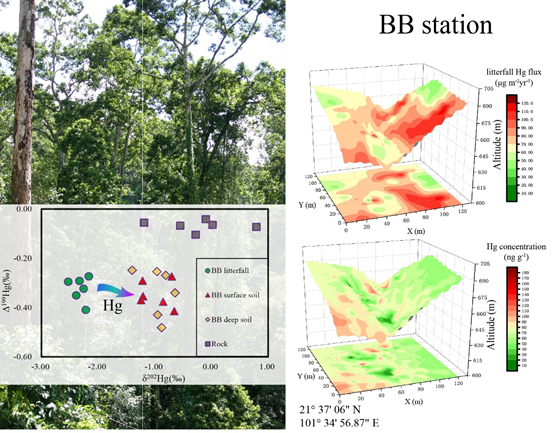Mercury (Hg), as a global pollutant, is directly emitted into the air — from geogenic and anthropogenic sources — and into the earlier deposited Hg in natural surfaces.
 Spatial distribution of surface soil Hg concentration in tropical forests of Xishuangbanna. Image Credit: Shangwen Xia.
Spatial distribution of surface soil Hg concentration in tropical forests of Xishuangbanna. Image Credit: Shangwen Xia.
Early studies performed in subtropical evergreen forests have revealed that vegetation, climate and terrain factors are behind Hg accumulation in the forest floors. But few studies have carried out an extensive observation of Hg mass balance in tropical forests.
In a study reported in the Journal of Hazardous Materials, scientists from the Xishuangbanna Tropical Botanical Garden (XTBG) and the Institute of Geochemistry of the Chinese Academy of Sciences tried to examine Hg mass balance in tropical forests ahead of a latitudinal gradient.
They illustrated that the tropical forest at the lowest latitude consists of the greatest litterfall Hg input but the smallest surface soil Hg concentration as the high microbial reduction processes induced loss of Hg.
The scientists made use of a 1-ha sampling plot, the most extensive technique for forest inventory, to evaluate Hg spatial accumulation in tropical forests. They selected three typical tropical forests situated in the transection region of tropical to subtropical zone in Southwest China to illustrate the difference of Hg accumulation in soils in reaction to the change of climate and vegetation.
The soil Hg concentration displayed a growing trend along with the latitudinal gradient in the three tropical forests. The tropical forest at the lowest latitude consisted of the greatest litterfall Hg input, but the smallest surface soil Hg concentration. Terrain and climate are considered to be the primary factors to trigger the spatial distributions of tropical Hg.
The researchers utilized Hg isotopic signatures to exhibit post-depositional Hg processes in soils. The Hg isotopic evidence revealed that microbial reduction primarily contributed to the loss of tropical Hg and isotopic fractionation. The slower turnover of nutrients in high latitude tropical forests would improve the Hg abiotic reductions which induced a small negative mass-independent fraction shift in soils.
Our study suggests that fast nutrient cycles in tropical forests possibly lead to a smaller atmospheric Hg net sink than in other forests.
Dr. Shangwen Xia, Xishuangbanna Tropical Botanical Garden
Journal Reference:
Xia, S., et al. (2022) Latitudinal gradient for mercury accumulation and isotopic evidence for post-depositional processes among three tropical forests in Southwest China. Journal of Hazardous Materials. doi.org/10.1016/j.jhazmat.2022.128295.